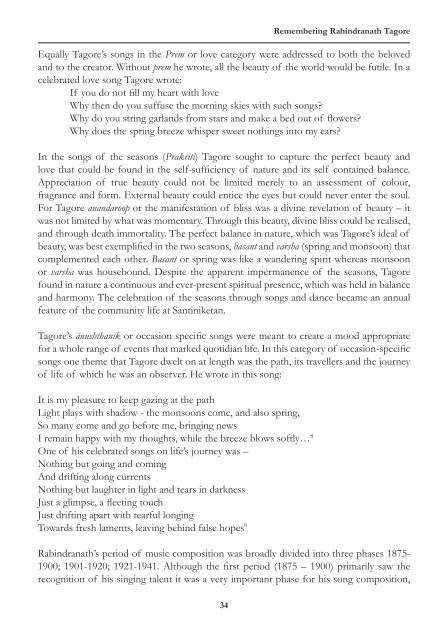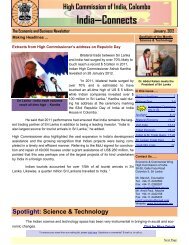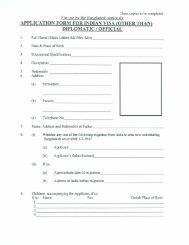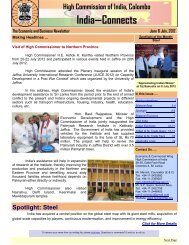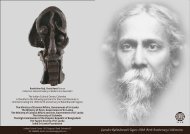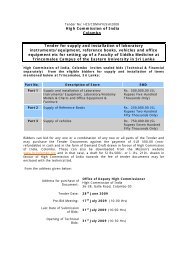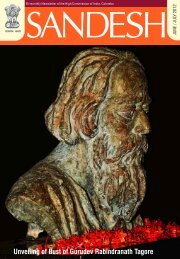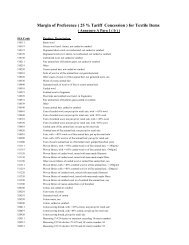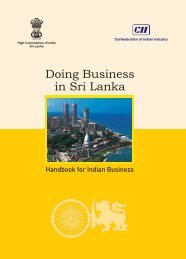Remembering Rabindranath Tagore Volume - High Commission of ...
Remembering Rabindranath Tagore Volume - High Commission of ...
Remembering Rabindranath Tagore Volume - High Commission of ...
You also want an ePaper? Increase the reach of your titles
YUMPU automatically turns print PDFs into web optimized ePapers that Google loves.
34<br />
<strong>Remembering</strong> <strong>Rabindranath</strong> <strong>Tagore</strong><br />
Equally <strong>Tagore</strong>’s songs in the Prem or love category were addressed to both the beloved<br />
and to the creator. Without prem he wrote, all the beauty <strong>of</strong> the world would be futile. In a<br />
celebrated love song <strong>Tagore</strong> wrote:<br />
If you do not fill my heart with love<br />
Why then do you suffuse the morning skies with such songs?<br />
Why do you string garlands from stars and make a bed out <strong>of</strong> flowers?<br />
Why does the spring breeze whisper sweet nothings into my ears?<br />
In the songs <strong>of</strong> the seasons (Prakriti) <strong>Tagore</strong> sought to capture the perfect beauty and<br />
love that could be found in the self-sufficiency <strong>of</strong> nature and its self contained balance.<br />
Appreciation <strong>of</strong> true beauty could not be limited merely to an assessment <strong>of</strong> colour,<br />
fragrance and form. External beauty could entice the eyes but could never enter the soul.<br />
For <strong>Tagore</strong> anandaroop or the manifestation <strong>of</strong> bliss was a divine revelation <strong>of</strong> beauty – it<br />
was not limited by what was momentary. Through this beauty, divine bliss could be realised,<br />
and through death immortality. The perfect balance in nature, which was <strong>Tagore</strong>’s ideal <strong>of</strong><br />
beauty, was best exemplified in the two seasons, basant and varsha (spring and monsoon) that<br />
complemented each other. Basant or spring was like a wandering spirit whereas monsoon<br />
or varsha was housebound. Despite the apparent impermanence <strong>of</strong> the seasons, <strong>Tagore</strong><br />
found in nature a continuous and ever-present spiritual presence, which was held in balance<br />
and harmony. The celebration <strong>of</strong> the seasons through songs and dance became an annual<br />
feature <strong>of</strong> the community life at Santiniketan.<br />
<strong>Tagore</strong>’s ānushthanik or occasion specific songs were meant to create a mood appropriate<br />
for a whole range <strong>of</strong> events that marked quotidian life. In this category <strong>of</strong> occasion-specific<br />
songs one theme that <strong>Tagore</strong> dwelt on at length was the path, its travellers and the journey<br />
<strong>of</strong> life <strong>of</strong> which he was an observer. He wrote in this song:<br />
It is my pleasure to keep gazing at the path<br />
Light plays with shadow - the monsoons come, and also spring,<br />
So many come and go before me, bringing news<br />
I remain happy with my thoughts, while the breeze blows s<strong>of</strong>tly… 8<br />
One <strong>of</strong> his celebrated songs on life’s journey was –<br />
Nothing but going and coming<br />
And drifting along currents<br />
Nothing but laughter in light and tears in darkness<br />
Just a glimpse, a fleeting touch<br />
Just drifting apart with tearful longing<br />
Towards fresh laments, leaving behind false hopes 9<br />
<strong>Rabindranath</strong>’s period <strong>of</strong> music composition was broadly divided into three phases 1875-<br />
1900; 1901-1920; 1921-1941. Although the first period (1875 – 1900) primarily saw the<br />
recognition <strong>of</strong> his singing talent it was a very important phase for his song composition,


